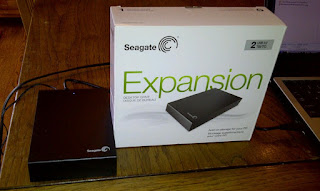What is the Best Backup Storage Solution?
It was time to get a better storage system for backing up files on the computers at the Pincher household. The old backup plan for the 4 laptops in our house:
 |
| Seagate 2 TB Expansion Drive, under $120 Image source: Dr. Penny Pincher |
- Laptop 1: Burn DVD's using Windows Vista's built-in 'Back Up Files'. Takes forever, but I had blank DVDs available. Do this a couple times a year.
- Laptop 2: Copy critical files to a 16 GB USB memory stick, usually around the 1st of each year
- Laptop 3: Kid's laptop, no backup at all
- Laptop 4: Other kid's laptop, no backup at all
Not good.
I wanted to do real backups on all of our computers. We have pictures, videos, school papers, and many other files that could not easily be replaced. Cloud backup may be an option, but I want something more tangible and without a monthly bill...
SATA USB Docking Station
I was inspired to check out the latest storage devices again when I saw a SATA USB docking station in action. It works like this- you take a standard computer hard drive (SATA), plug it into the USB docking station hooked up to a computer, and write files to it. You can remove the hard drive from the dock and plug another one into the dock. Essentially unlimited backup capacity- just get another SATA drive and keep going. The dock costs about $40 dollars, and a 1 TB drive costs about $75. There are also USB cable adapters that are a similar concept that cost even less, I have seen these for about $15.
 |
| "Bare" SATA Hard Drive. Image courtesy of Sorapop at FreeDigitalPhotos.net |
External Hard Drive
I was ready to buy a USB SATA dock and a 1 TB SATA hard disk. Maybe two of the 1 TB hard disks. But I decided to check out portable hard drives. The nice thing about a portable hard drive is that it has an enclosure around the hard disk. Using SATA drives, the bare hard drives would be unprotected and would need to be handled carefully to protect them from static electricity, impact, etc. Also, would I really need more than one hard drive? The main benefit of using a SATA USB dock is that you can remove the drive and switch to another one as you need more storage capacity. I might only need one drive to back everything up.
I checked out external hard drives with enclosures. They are not much more expensive than the bare SATA drives and include the built-in power supply and enclosure. I found 1 TB external hard drives for about $100, and 2 TB for $129.99.
I found a Seagate Expansion 2 TB drive with USB 3.0 at Target for $119.99 this morning. That should handle all of my backup needs for awhile, and I don't need to worry about handling and storing bare hard drives. Let the backups commence!
Update: The next day this exact model of 2 TB external drive was reduced in price to $107.99. I brought my receipt and a drive from the shelf to the customer service department at Target- they gave me a "price adjustment" for $12.72.
Mac and PC Backup on One Drive
I had backed up a couple PC laptops: one Windows Vista and one Windows 7. Up next was a Mac OS X laptop. I planned to use the built-in Time Machine to create the Mac backup. When I connected the external drive and launched Time Machine, it offered to erase and reformat the drive for me. It would not use the NTFS formatted drive that worked so well for the PCs. I wanted a simple and harmonious backup storage solution. This was turning out to be complex and disharmonious. Time for a cup of coffee...
OK. Here's the plan. We'll use some of the empty space on the external drive to make a new disk partition using built-in Windows 7 disk tools. There's plenty of empty space. We'll format it in the PC NTFS format, and then let Time Machine do what it wants with the new partition. I set aside 325 GB for the new Mac partition following these directions from CNET. Worked great.
Penny Pinching Tips:
- Back up your computer files- you'll waste time and money trying to recover data if you loose files
- Hard drives are getting cheaper all the time- about $100 gets you 1 TB (that's 1000 GB, or 1,000,000 MB)
- External drives include power supply and drive enclosure built-in, and likely have enough capacity for all of your files. Check out External hard drive deals on eBay
.
- If you have extreme amounts of data, you'll save money using a SATA USB dock with replaceable SATA drives. Check out SATA USB docking station deals on eBay
.
Recommended reading:
Best Cheap Android Tablets- Worth the Money?
Use a Cheap USB Flash Memory Stick to Make Your PC Blazing Fast for $12.99
